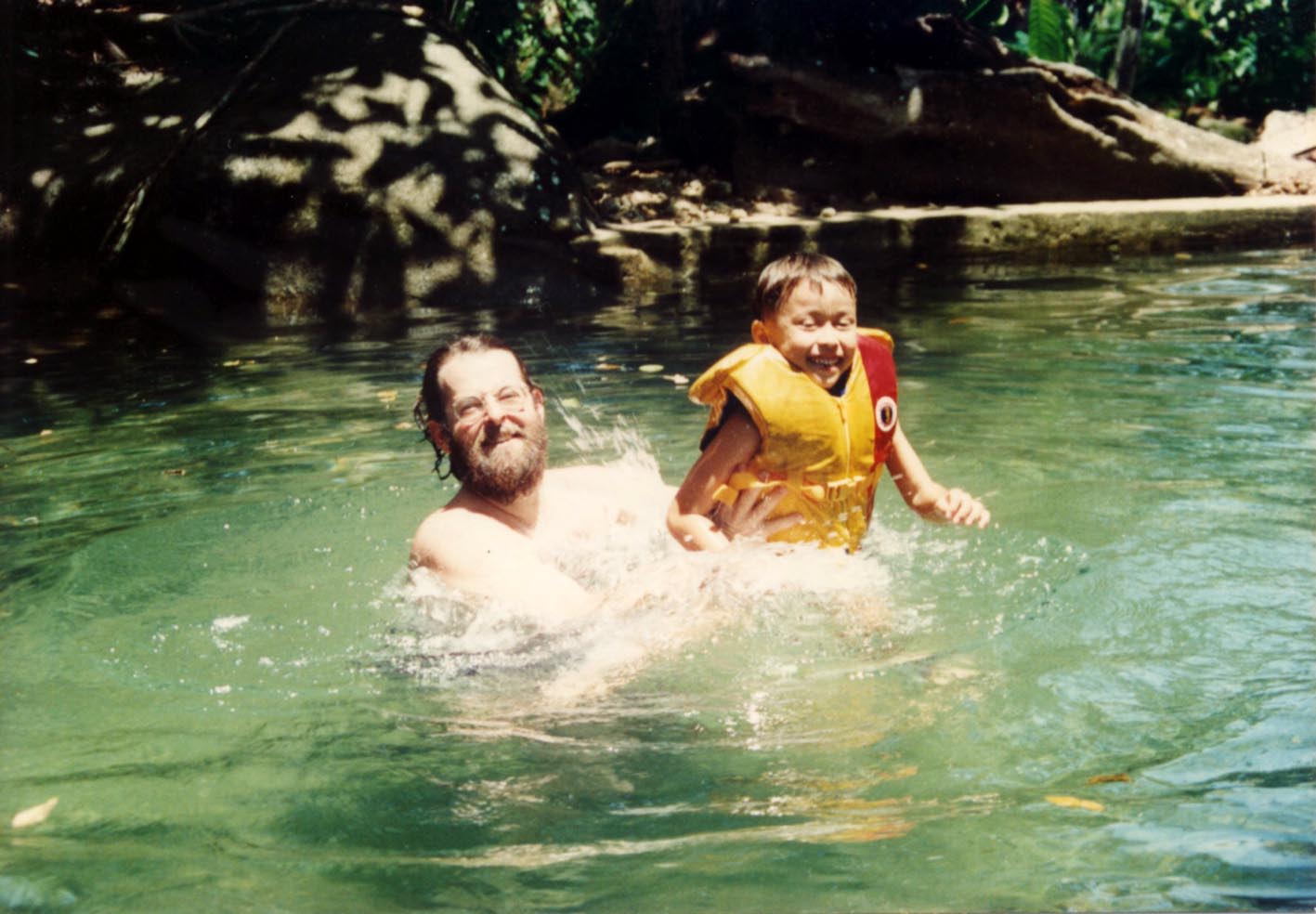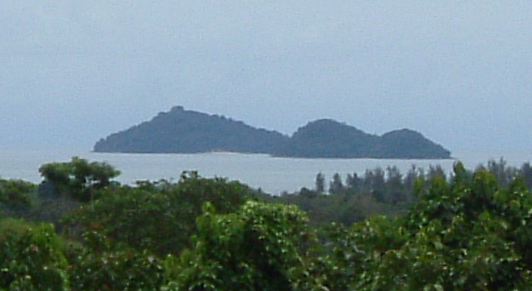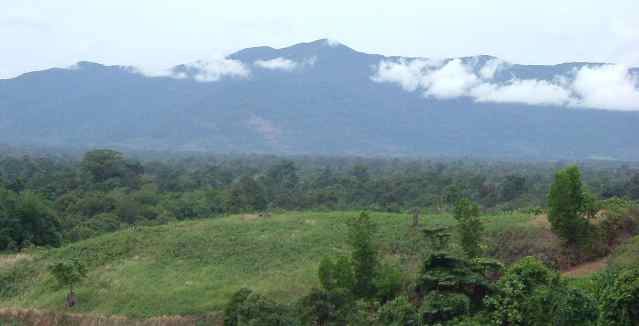Les Délices de Lundu,
orThe Delights of Lundu,
together with Information Useful to Visitors.
Getting Around
If you don't have a car or a motorbike, getting from place to place in the Lundu area is difficult. Busses run to Sematan, and to Kampong Pandan, but are infrequent and service stops mid-afternoon. There are no taxis in Lundu, nor bicycles for rent, and distances are too great conveniently to walk. Bear this in mind when you make plans. Tour operators in Kuching regularly bring people on excursions down to Lundu, and a day-trip with transport is easy to arrange.Gunung Gading National Park
You have already seen the three beautiful peaks of Gunung
Gading, a handsome basaltic mountain directly to the west of Lundu town.
From here comes our water-supply, excellent pure mountain water. The
whole of Gunung Gading is gazetted as Gunung Gading National Park. Miles
of trails lead through the forest to outlooks and waterfalls. Some of
these are arduous. Lower down the park authorities have built a raised
boardwalk of belian wood through the forest. [Note: in Sarawak, "forest"
means untouched growth; secondary growth is called "jungle."]
This walk makes a circuit of about a kilometer. There are
many places in the woods just off the trail where the Rafflesia can
be seen in season. Now and again other wonderful exotic flowers will bloom.
The guides at the park are very well informed. If you telephone the
park, they will will be happy to tell you if a Rafflesia is in
bloom, and when you get there, they will guide you to the flower for a
small fee. The Gunung Gading National Park Website can be found here.
Admission to Gunung Gading Park costs RM10.00 for adults and half that for children. Be advised that there are fees charged for bringing in still and video cameras. Inside the entrance to Gunung Gading Park one finds a building with offices for the rangers, and attached to that a small museum built in the shape of a Bidayuh "headhouse." Here you may see a topographical model of the mountains and park, and exhibits on the Rafflesia, other interesting wildlife, and curious spots. During the early years of the 1960s, when Indonesia and Malaysia
 were engaged in an undeclared war called "Konfrontasi," adherents
of the communist movement hid themselves in the forests of the mountain.
This was a tragic time. Sons and daughters of local people joined the
communist movement, and some were killed by British forces putting down
the insurgency.
were engaged in an undeclared war called "Konfrontasi," adherents
of the communist movement hid themselves in the forests of the mountain.
This was a tragic time. Sons and daughters of local people joined the
communist movement, and some were killed by British forces putting down
the insurgency.
Gunung Gading National Park also has a spot for having picnics, and for camping. The park also has chalets and shared rooms which one can book for the stay of one night or several. A beautiful mountain stream pours down from the summit into a sandy-bottomed pool not far from the main buildings. This pool, at the head of the boardwalk trail, is a favorite picnic and swimming spot for both local people and for visitors from Kuching. The water is crystal clear and cold. Little fish, if you're patient, will come up and nibble on your toes. This is a very pleasant place to spend a afternoon
getting away from the heat. The scenery is very beautiful, and the absolute
true picture of the Romantic Tropical Jungle. The photo on the left shows
Sam under water in the pool. The other is Sam with my late brother Karl.
nibble on your toes. This is a very pleasant place to spend a afternoon
getting away from the heat. The scenery is very beautiful, and the absolute
true picture of the Romantic Tropical Jungle. The photo on the left shows
Sam under water in the pool. The other is Sam with my late brother Karl.
NB. On weekends there are lots of people there, and the water can get roiled up and a bit murky.
The short road to Gunung Gading National Park opens up on the left side of the road out of Lundu towards Pandan, about a mile from the center of town. This entrance is obscured by a tight curve, and I urge people who are driving there to be careful.
For more information go to: http://www.forestry.sarawak.gov.my/forweb/np/np/gading.htm, the Forestry Dept.'s website on Gunung Gading, or to the Sarawak Tourism Board's Gunung Gading website: http://www.sarawaktourism.com/gading.html
Along the road from Lundu to Pandan near the beaches there are a handful of resorts. We have no personal experience of these, because we live here. They are certainly worth looking into. As I update this page I will include names and phone numbers.
Places to Stay, Places to Eat.
People who are mostly interested in visiting and hiking in Gunung Gading National Park will do best making a booking to stay in one of the Park's chalets or shared rooms. Or they can bring camping gear and set up a tent on the grass. If you do stay there, be sure to stock up on food and drink while you are in town, as the Park has no canteen. The markets in Lundu are full of good, fresh food. Fish is best bought early in the morning. The catch comes at high tide. The vegetable market is in my opinion better than Kuching's.
Lundu town does not offer much accomodation. The small Lundu Gading Hotel is located on the back side of the Padang, towards the mountain and facing the RHB Bank. The Lundu Gading Hotel is your basic utilitarian Chinese hotel, although the rates are somewhat higher than average. There is also the Hak Cheng Rooming House, on the opposite side of the same street, of which, again, we have no experience, not even to know if they take tourists. In future new places, including homestays, may appear.
Lundu town has plenty of good places to eat. We have many coffeshops that serve drinks, including beer. Ask for the special: three tins of Tiger Beer for RM10.00, instead of getting bottles. I enjoy beer in Singkeh's coffeeshop, on the north-east corner of the Padang facing the Shell station. Singkeh's shop is quiet and clean. Most coffeeshops also serve noodles, chicken-rice, and such, although many people stop cooking after noontime. Food is served all the time in the "food court" on top of the Vegetable Market. We especially recommend the coffee/noodle shop on the south-west corner of the Padang, opposite the fish-market. Also the Happy Seafood Center, a delightfully breezy shop on the corner of the new shophouse row, facing the Agriculture Dept. The best place in town is the seafood place right next to the bus-station, in the row next to the Chinese temple. They do fish and prawns very well.
Miscellaneous note. To get a newspaper---if you like to read the paper with your coffee---go to the stationery store on the S-W row of shops on the Padang. English papers sell out early!
Off of Sematan, slightly to the east, lie the two "Turtle Islands," Talang-Talang. These have been administered by the Sarawak Museum as a sanctuary for sea-turtles since the 1950s, when Tom Harrisson established a conservation program. The Museum has a bungalow on the main island. This used to be available for people to stay in, but when I last inquired I was told that the island was closed and the building being repaired. I took the photo below from the vantage of the silkworm-farm.

The western slopes of Gunung Gading, as seen from the silkworm-farm at Sematan.

Sematan is a very small town with, as I remember, exactly one place to eat, and one place to stay. The beaches at Sematan and at Pueh, still further to the west, are all of very, very gradually sloping sand, so that you may have to walk out a quarter of a mile at low tide to get to the water. Plenty of casuarinas. Nonetheless, there are apparently some very good sites for scuba diving around Sematan. A Mr. Law runs the Sematan Scuda Diving and Water Sports. There is an article about him here; however, the URL listed there is out of date, and I have not found a new one.
At the very end of Sarawak Tanjung Dato’---"Cape Dato"---juts out into the sea. Tanjung Dato’ is Sarawak's newest national park. For information, go to: http://www.forestry.sarawak.gov.my/forweb/np/np/tandatu.htm
Admission to Gunung Gading Park costs RM10.00 for adults and half that for children. Be advised that there are fees charged for bringing in still and video cameras. Inside the entrance to Gunung Gading Park one finds a building with offices for the rangers, and attached to that a small museum built in the shape of a Bidayuh "headhouse." Here you may see a topographical model of the mountains and park, and exhibits on the Rafflesia, other interesting wildlife, and curious spots. During the early years of the 1960s, when Indonesia and Malaysia
 were engaged in an undeclared war called "Konfrontasi," adherents
of the communist movement hid themselves in the forests of the mountain.
This was a tragic time. Sons and daughters of local people joined the
communist movement, and some were killed by British forces putting down
the insurgency.
were engaged in an undeclared war called "Konfrontasi," adherents
of the communist movement hid themselves in the forests of the mountain.
This was a tragic time. Sons and daughters of local people joined the
communist movement, and some were killed by British forces putting down
the insurgency.Gunung Gading National Park also has a spot for having picnics, and for camping. The park also has chalets and shared rooms which one can book for the stay of one night or several. A beautiful mountain stream pours down from the summit into a sandy-bottomed pool not far from the main buildings. This pool, at the head of the boardwalk trail, is a favorite picnic and swimming spot for both local people and for visitors from Kuching. The water is crystal clear and cold. Little fish, if you're patient, will come up and
NB. On weekends there are lots of people there, and the water can get roiled up and a bit murky.
The short road to Gunung Gading National Park opens up on the left side of the road out of Lundu towards Pandan, about a mile from the center of town. This entrance is obscured by a tight curve, and I urge people who are driving there to be careful.
For more information go to: http://www.forestry.sarawak.gov.my/forweb/np/np/gading.htm, the Forestry Dept.'s website on Gunung Gading, or to the Sarawak Tourism Board's Gunung Gading website: http://www.sarawaktourism.com/gading.html
Siar and Pandan Beaches
Two beaches lie to the west of Lundu on the South China Sea. The first is Siar Beach, and at the end of the road is Pandan Beach. Both have their associated Malay kampongs. These beaches, and particularly Pandan Beach, are popular places that people from Kuching visit on weekends. During weekdays they go back to being Deserted Tropical Beaches—except for a few fishermen coming in and out. The water here is warm and clean, although not exceptionally clear because of the waves on shelving sand. At high tides the water will reach the very limit of the sands, and during monsoon season the surf can be violent. The sea here is not suitable for diving, nor for surfing. It's a place to go swimming and to walk. Pandan Beach extends for about a kilometer in the shape of a shallow crescent. A rugged jumble of basalt sits on the western end, and an equally rugged hill with cliffs on the eastern. One small shop sells drinks and snacks, and the villagers have built a public toilet where one can shower off with fresh water after swimming.Along the road from Lundu to Pandan near the beaches there are a handful of resorts. We have no personal experience of these, because we live here. They are certainly worth looking into. As I update this page I will include names and phone numbers.
Places to Stay, Places to Eat.
People who are mostly interested in visiting and hiking in Gunung Gading National Park will do best making a booking to stay in one of the Park's chalets or shared rooms. Or they can bring camping gear and set up a tent on the grass. If you do stay there, be sure to stock up on food and drink while you are in town, as the Park has no canteen. The markets in Lundu are full of good, fresh food. Fish is best bought early in the morning. The catch comes at high tide. The vegetable market is in my opinion better than Kuching's.
Lundu town does not offer much accomodation. The small Lundu Gading Hotel is located on the back side of the Padang, towards the mountain and facing the RHB Bank. The Lundu Gading Hotel is your basic utilitarian Chinese hotel, although the rates are somewhat higher than average. There is also the Hak Cheng Rooming House, on the opposite side of the same street, of which, again, we have no experience, not even to know if they take tourists. In future new places, including homestays, may appear.
Lundu town has plenty of good places to eat. We have many coffeshops that serve drinks, including beer. Ask for the special: three tins of Tiger Beer for RM10.00, instead of getting bottles. I enjoy beer in Singkeh's coffeeshop, on the north-east corner of the Padang facing the Shell station. Singkeh's shop is quiet and clean. Most coffeeshops also serve noodles, chicken-rice, and such, although many people stop cooking after noontime. Food is served all the time in the "food court" on top of the Vegetable Market. We especially recommend the coffee/noodle shop on the south-west corner of the Padang, opposite the fish-market. Also the Happy Seafood Center, a delightfully breezy shop on the corner of the new shophouse row, facing the Agriculture Dept. The best place in town is the seafood place right next to the bus-station, in the row next to the Chinese temple. They do fish and prawns very well.
Miscellaneous note. To get a newspaper---if you like to read the paper with your coffee---go to the stationery store on the S-W row of shops on the Padang. English papers sell out early!
Other.
From the map on Lundupage Two, I think you will be able to find the bank, post office, and other places you may need to go. The Hospital is located about 300 m from the post office on the left side of the road towards Pandan. Dr. George Paulus Sabang has a private clinic in the newest row of shophouses opposite the Agriculture Dept., down from the Happy Seafood Center. To make phone calls you will need a phone card, as the Telekom office, next to the Post Office, is a small purely administrative affair. An internet café came and went; it may be possible to send an e-mail from the computer tuition center—also in the new shophouse row—or from the District Council office.To the West of Lundu.
The main road goes west from Lundu to Sematan and Pueh. Not far out from Lundu towards the west one can turn left, to the south, and drive up an improved road to Biawak, on the border with Indonesia. There is not much there except a very small pasar connected with an army camp. Before Sematan, also to the left, is a farm that raises silkworms. All views from the hill are beautiful, the mountain at the back beautiful, the air is cool and the silkworms are pretty cool too. The hill is planted thickly with paper mulberrys, Broussonetia papyrifera, a member of the hibiscus family. The Tahitians, Hawai'ians, and other peoples of the Pacific made their famous tapa cloth out the inner bark of this plant, although I do not believe that Borneo people ever used this for bark-cloth.Off of Sematan, slightly to the east, lie the two "Turtle Islands," Talang-Talang. These have been administered by the Sarawak Museum as a sanctuary for sea-turtles since the 1950s, when Tom Harrisson established a conservation program. The Museum has a bungalow on the main island. This used to be available for people to stay in, but when I last inquired I was told that the island was closed and the building being repaired. I took the photo below from the vantage of the silkworm-farm.

The western slopes of Gunung Gading, as seen from the silkworm-farm at Sematan.

Sematan is a very small town with, as I remember, exactly one place to eat, and one place to stay. The beaches at Sematan and at Pueh, still further to the west, are all of very, very gradually sloping sand, so that you may have to walk out a quarter of a mile at low tide to get to the water. Plenty of casuarinas. Nonetheless, there are apparently some very good sites for scuba diving around Sematan. A Mr. Law runs the Sematan Scuda Diving and Water Sports. There is an article about him here; however, the URL listed there is out of date, and I have not found a new one.
At the very end of Sarawak Tanjung Dato’---"Cape Dato"---juts out into the sea. Tanjung Dato’ is Sarawak's newest national park. For information, go to: http://www.forestry.sarawak.gov.my/forweb/np/np/tandatu.htm